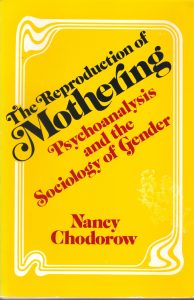Women Mothers Daughters: The Reproduction of Mothering After Forty Years
by Nancy J. Chodorow, PhD
This essay, included in a recent tribute publication edited by Petra Bueskens, shows Nancy Chodorow’s own reflections on her influential 1978 book The Reproduction of Mothering. In lieu of an abstract, here is a brief excerpt of the content:
I, as a woman, ask in amazement, and what about motherhood?
~ Karen Horney, 1926
For we think back through our mothers if we are women.
~ Virginia Woolf, 1929
Women mother daughters who, when they become woman, mother.
~ Nancy Chodorow, 1978

Women mother. So opens The Reproduction of Mothering. Here is a book about mother and daughter, the intertwining of generation and gender, even as I myself have changed generations and developed. It is a great honor, and also daunting, to be invited to look back on this book after 40 years.
The Reproduction of Mothering comes from a time in second-wave feminism when the personal was political, but feminists were with rare exception hostile to psychoanalysis and suspicious of any account that began from the psyche rather than from political and economic forces. The book argues that the personal is personal, and that that’s important in itself, even as it also shows how the personal connects to the socio-cultural and political-economic. I begin from everyday, observing that the mother-daughter relationship – especially, being a daughter – seems important in women’s experience and development. I explore, in an open-ended way, this relationship over the course of the daughter’s development: how do we understand this important relationship, especially in the daughter’s psyche and development? How is it being the mother of a daughter? How do women become mothers? I discover that these questions are connected, that it is through the mother-daughter relationship, through women’s mothering, that daughters develop maternality. The female relatedness that develops in the mother-daughter relationship and goes on into mothering is described by women writers in novels, autobiography, memoir, poetry, even as this foundational emotional and relational experience and identity helps to put women into a psychosocial and psychocultural world of gender inequality and male dominance<…>.
Bueskens, P., ed. Nancy Chodorow and The Reproduction of Mothering: Forty Years On. Palgrave, 2021, pp. 49-80.
Link to Online Publication [fulltext can be requested from the library].
About the Author

Nancy J. Chodorow, PhD, is Training and Supervising Analyst Emerita at the Boston Psychoanalytic Society and Institute; Lecturer in Psychiatry at Harvard Medical School; and Professor Emerita of Sociology at University of California, Berkeley. She is a pioneer psychoanalytic feminist, discovered and named the American independent tradition, and has written on comparative psychoanalytic theory and psychoanalysis and the social sciences. She is the author of six books: The Reproduction of Mothering (1978, 1999); Feminism and Psychoanalytic Theory (1989); Femininities, Masculinities, Sexualities (1984); The Power of Feelings: Personal Meaning in Psychoanalysis, Gender and Culture (1999); Individualizing Gender and Sexuality (2012); and The Psychoanalytic Ear and the Sociological Eye: Toward an American Independent Tradition (2020), which was discussed at the BPSI Meet the Author Webinar on May 4, 2021 (click here to watch the video recording). Nancy Chodorow and The Reproduction of Mothering: Forty Years On (Bueskens P., ed., Palgrave, 2021) was celebrated by Maternal Scholars Australia’s virtual book launch on June 25, 2021 (click here to watch the video recording).
Previous Posts:
Anthony D. Bram, PhD. (2021). Introduction – In-Session Use of Digital Material in Child Psychoanalysis and Psychotherapy. The Psychoanalytic Study of the Child, 74(1): 304-307.
Steven H. Cooper, PhD. (2021). Toward an Ethic of Play in Psychoanalysis. The Psychoanalytic Quarterly, 90:3, 373-397.
Diane O’Donoghue, PhD. (2021). Amnesias of a Freudian Kind. Part One. American Imago 78(1), 55-77.
Charles Levin, PhD and Dawn Skorczewski, PhD. (2020).The Poetics of Boundary Violation: Anne Sexton and Her Psychiatrist. Psychoanalytic Dialogues, 30(2), 206-221.
Andrea Celenza, PhD (2020). Embodiment and the Perversion of Desire. The Psychoanalytic Quarterly, 89(3), 369-398.
Steven H. Cooper, PhD (2021). Donald Winnicott and Stephen Mitchell’s Developmental Tilt Hypothesis Reconsidered. Psychoanalytic Dialogues, 31(3), 355-370.
Elsa Ronningstam, PhD (2021). Cultural Function and Psychological Transformation of Silence in Psychoanalysis and Psychotherapy. In Dimitrijevic, A. and Buchholz, M.B., eds. (2021). Silence and Silencing in Psychoanalysis: Cultural, Clinical, and Research Perspectives. Routledge, pp. 105-127.
Paola M. Contreras, PsyD (2021). The Magical and the My-Person in Psychoanalysis During the Covid Pandemic. Journal of the American Psychoanalytic Association, 68(6): 1113-1126. Open Access, DOI: 10.1177/0003065120981733
Don R. Lipsitt, MD (2020). In Freud’s Pocket: A Totem of Medical Ambivalence? American Imago, 77(4): 738-751.
Rachel Brier, EdD and Anna Ornstein, MD (2020). Tracking Changes in the Disruption/Repair Sequences: Important Aspects of Clinical Work. Psychoanalysis, Self and Context.
Rodrigo Barahona, PsyaD (2020). Living the Non-Dream: An Examination of the Links Between Dreaming, Enactment, and Transformations in hallucinosis. The Psychoanalytic Quarterly, 89:4, 689-714.
Sarah Ackerman, PhD (2020). A Diagnosis for Psychoanalysis in the 21st Century: Freud as Medicine. The Psychoanalytic Quarterly, 89:4, 667-688.
Lora Tessman, PhD (2020). Review of Ghost in the Human Psyche: The Story of a ‘Muslim Armenian’ , by Vamik D. Volkan. Contemporary Psychoanalysis, 56(2-3):457-464.
Click here to see a full archive of featured papers. All articles can be requested from the library.

